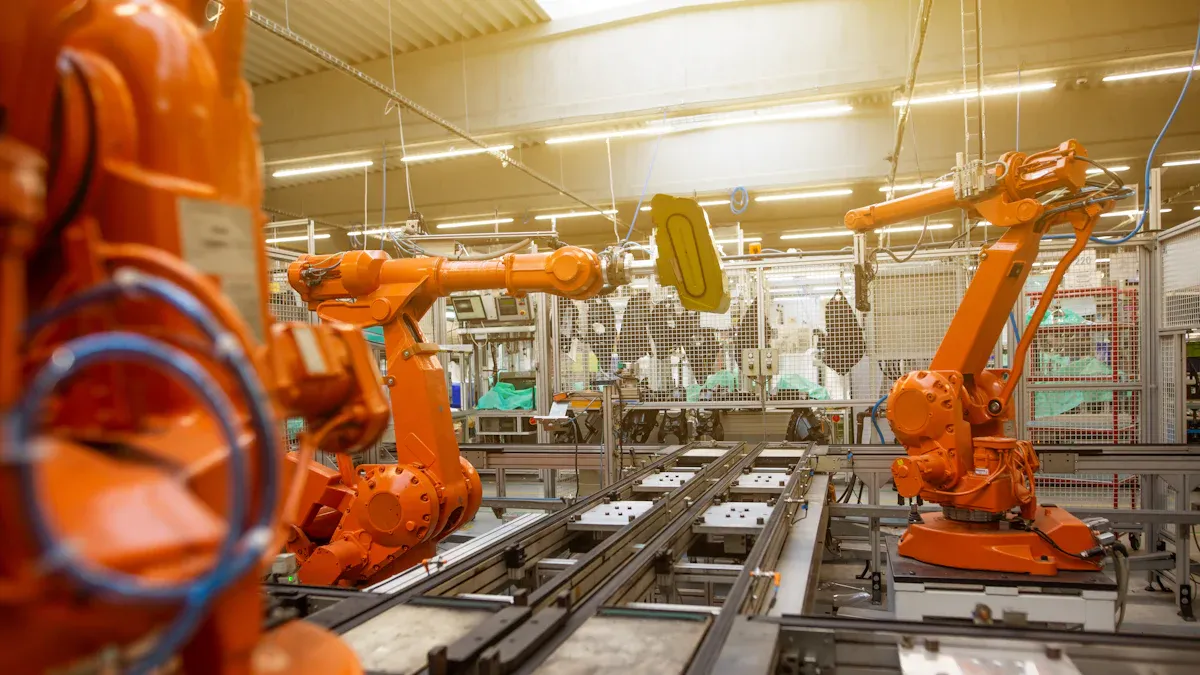What Is Tolerance Stacking? Importance, Analysis Methods and Practices

What Is Tolerance Stacking describes how small dimensional differences from each part add up in an assembly. You use this process to make sure all parts fit and work together as designed. Tolerance stacking matters because even tiny variations can lead to gaps, misalignments, or failures in mechanical assemblies. Research shows that careful management of these accumulated differences improves reliability and reduces the risk of costly errors.
Engineers often use both worst-case and statistical methods to predict how these variations affect assemblies, helping you achieve better quality and lower costs.
What Is Tolerance Stacking?

Definition
When you ask, “What Is Tolerance Stacking?” you look at how small dimensional differences in each part add up in an assembly. Tolerance stacking, also called tolerance stack-up, means you add the allowed variations (tolerances) from each part or feature to see their total effect. This process helps you predict if the final assembly will fit and function as intended.
Tolerance stacking is not just about one part. You consider all connected features and their tolerances together. This approach ensures that the whole assembly meets design requirements, not just the individual pieces.
You find this concept used across many industries, including automotive, electronics, medical devices, and aerospace. No matter the field, the core idea stays the same: you manage the sum of all small variations to guarantee the assembly works.
Here are the key components included in the definition of tolerance stacking:
- You sum the geometric tolerances of connected features.
- You analyze these tolerances before manufacturing to check feasibility and performance.
- You use methods like worst-case analysis and statistical analysis (such as root sum square and Monte Carlo).
- You ensure that all parts and assemblies fit together within specified limits.
- You optimize cost and manufacturability by preventing errors in production.
Purpose
You use tolerance stacking to make sure all parts fit together correctly in the final product. The main goal is to avoid surprises during assembly, such as gaps, misalignments, or failures. When you perform tolerance stacking analysis, you can:
- Predict if the assembly will work under different conditions, such as temperature changes or mechanical loads.
- Identify potential problems early, which saves time and money by reducing the need for rework.
- Optimize tolerances for cost and manufacturability, so you do not make parts more precise than necessary.
- Reduce the number of prototypes needed, which speeds up development.
You also use tolerance stacking to support robust design. This means your product will keep working even when small variations occur in manufacturing. By understanding what is tolerance stacking, you can set realistic and practical tolerances that balance quality and cost.
If you ignore tolerance stacking, you risk costly production delays, increased scrap, and even safety issues. Even if each part meets its own tolerance, the combined effect can cause the whole assembly to fail.
Accumulation
Accumulation describes how individual tolerances add up in an assembly. You might have three parts, each with a ±0.1 mm tolerance. When you assemble them, the total possible variation becomes ±0.3 mm. This total, or stack-up, can affect whether the assembly fits and functions as designed.
You use several mathematical models to describe this accumulation:
| Mathematical Model Type | Description / Usage |
|---|---|
| Interval Analysis | Uses intervals to represent tolerance ranges and accumulates uncertainty |
| Modal Interval Analysis | Extends interval analysis for semantic tolerance modeling |
| Fuzzy Logic Models | Handles asymmetric tolerances and uncertainty with fuzzy sets |
| Statistical Tolerance Analysis | Uses probability and statistics to estimate total variation |
| Worst-Case Analysis | Assumes maximum possible deviation for each part |
| Root Sum Squares (RSS) Method | Combines tolerances statistically, assuming independence |
| Computer-Aided Tolerancing | Uses software to integrate various mathematical models |
You choose the right model based on your product’s needs. For high-precision assemblies, you might use worst-case analysis to guarantee fit. For high-volume production, statistical methods like RSS or Monte Carlo simulations help you balance quality and cost.
What Is Tolerance Stacking teaches you that even small, acceptable variations can add up to big problems if you do not analyze them. By understanding accumulation, you prevent assembly issues and improve product reliability.
If you skip this step, you may face assembly delays, increased waste, or even safety risks. You also risk higher production costs from discarded parts or the need for advanced manufacturing techniques. That is why you must always consider accumulation when you design and build assemblies.
Importance
Product Quality
Tolerance stacking plays a key role in product quality. When you assemble parts, small variations in each component can add up. These cumulative differences may cause defects such as poor fit or interference. As a result, you might see higher defect rates and more customer returns. For example, in the automotive industry, balancing tolerances ensures doors fit well, which prevents wind noise and leaks. Using statistical methods like Monte Carlo simulations helps you predict and manage these variations. By identifying key part characteristics and controlling critical features with tighter tolerances, you can reduce defects and improve performance. Manufacturers who optimize tolerance allocation see fewer returns and higher customer satisfaction.
According to the National Institute of Standards and Technology (NIST), improper tolerance management causes about 20% of assembly failures in manufacturing projects.
You can see how important it is to analyze and manage tolerance stacking early in the design process.
Assembly Fit
You rely on proper tolerance stacking to ensure all parts fit together as intended. If you ignore how tolerances add up, you risk assembly issues. For instance, in an engine block, if bores and flat surfaces each reach their tolerance limits, pistons may not fit or components may misalign. Even when each part meets its own tolerance, the combined effect can cause misalignment or loose assemblies. This can lead to functional failures and costly rework. By coordinating tolerances, you prevent unexpected gaps or interference, making sure your assemblies work as designed.
Manufacturing Cost
Tolerance stacking also affects manufacturing cost. When you specify unnecessarily tight tolerances, you increase production expenses. Tighter tolerances require more precise machines, longer processing times, and stricter quality control. This raises scrap rates and waste. Over-tolerancing can drive up costs without improving product performance. On the other hand, optimizing tolerance stacking allows you to balance quality and manufacturability. You can reduce costs by allowing greater variation where possible, minimizing scrap, rework, and delays. For example, tolerance stack-up analysis in aerospace manufacturing has led to a 25% reduction in costs and a 30% improvement in quality.
| Strategy/Technique | Cost-Saving Benefit | Example Outcome |
|---|---|---|
| Statistical Process Control | Reduces scrap and rework by controlling variability | 50% reduction in scrap and rework; 25% quality improvement (Medical devices) |
| Tolerance Stack-up Analysis | Identifies variability issues to prevent defects | 25% reduction in manufacturing costs; 30% quality improvement (Aerospace) |
| Robust Design | Designs insensitive to variability, reducing warranty claims | 40% reduction in warranty claims; 20% reliability improvement (Automotive) |
By understanding what tolerance stacking is and why it matters, you can improve product quality, ensure assembly fit, and control manufacturing costs.
Analysis Methods

Worst-Case
You use the worst-case analysis method to ensure that assemblies always fit, even when every part is at its tolerance limit. This approach gives you the maximum possible variation in an assembly. You follow these steps:
1. Create the dimension chain to determine the direction of tolerances. 2. Calculate the total nominal dimension by summing the nominal sizes of all components. 3. Calculate the total tolerance by adding all upper and lower tolerances. 4. Calculate the upper and lower limits of the assembly by adding and subtracting the total tolerance from the total nominal dimension.
This method assumes every part reaches its extreme tolerance at the same time. You get strong risk mitigation, but you often end up with very tight tolerances and higher costs. The worst-case method gives you a quick way to check the maximum possible deviation, but it may not reflect real-world manufacturing variation.
Tip: Always pay attention to the direction of each tolerance and use consistent sign conventions when building your dimension chain.
Statistical
Statistical analysis methods, such as Root Sum Square (RSS) and Monte Carlo simulation, help you predict how likely an assembly will meet its requirements. RSS works well for simple, linear assemblies where part variations follow a normal distribution. You add the means and combine the standard deviations using the root sum square formula. This method gives you a realistic estimate of total variation and often allows for wider tolerances, reducing costs.
Monte Carlo simulation takes a different approach. You use random sampling to simulate thousands of assembly scenarios. This method handles complex, non-linear assemblies and non-normal distributions. Monte Carlo gives you a probability estimate for assembly success or failure. Both methods help you identify which parts contribute most to variation, so you can target improvements.
Statistical methods improve manufacturing yield by treating tolerances as variables, not fixed extremes. You can predict the probability of assembly success, reduce scrap, and optimize tolerances for cost and quality.
Standards
You rely on international standards to guide your tolerance stacking analysis. ISO 286 provides a system for defining tolerance grades and fits, especially for holes and shafts. You use letter and number codes, such as H7/h6, to specify the amount of play or tightness between parts. This standard helps you control manufacturing variation and ensures parts fit together as designed.
Geometric Dimensioning and Tolerancing (GD&T), defined by ISO 1101 and ASME Y14.5, lets you control geometric features like form, orientation, and position. You use GD&T for high-precision assemblies where function depends on more than just size.
| Aspect | ISO 286 (Traditional Linear Tolerancing) | GD&T (ISO 1101) |
|---|---|---|
| Control Focus | Size and fits | Geometry: form, orientation, position |
| Complexity | Simple, easy to interpret | Complex, requires training |
| Inspection Method | Gauges, micrometers | CMMs, digital metrology |
| Cost Management | Good for rough machining cost control | Targets critical features for precision |
| Best Use Case | Non-critical structural parts | Functional, high-precision components |
You use these standards to ensure quality, interchangeability, and functional fit in your assemblies.
Best Practices
Design Tips
You can minimize the negative effects of tolerance stacking by following proven design strategies:
- Run a stackup study using modeling software to analyze extreme variations and spot assembly issues early.
- Avoid over-tolerancing. Only apply tight tolerances to critical surfaces. Looser tolerances on non-critical features reduce cost and complexity.
- Choose surface finishes that match the function. Use smoother finishes for sliding or firm contact surfaces.
- Communicate clearly with your machining partners about mating parts and fit types.
- Work with a single contract manufacturer for both mating parts and assembly to streamline the process.
Using Geometric Dimensioning and Tolerancing (GD&T) helps you control features directly, reducing cumulative errors. GD&T tools like Maximum Material Condition (MMC) modifiers give you bonus tolerance, making assemblies more robust and cost-effective.
Manufacturing Tips
You improve product quality by adjusting your manufacturing process:
- Use worst-case analysis for critical assemblies to guarantee fit, but apply statistical methods like Root Sum Square (RSS) or Monte Carlo simulations for most cases to allow wider tolerances.
- Avoid over-dimensioning. Specify tolerances only on features that affect function.
- Evaluate which features most impact assembly and focus your efforts there.
- Account for post-manufacturing changes, such as coating or welding, that may alter dimensions.
- Use CAD and tolerance analysis software to simulate and optimize stacks before production.
Documentation
Clear documentation ensures everyone understands tolerance requirements:
- Specify tolerances on drawings using standard notation and terminology.
- Reference standards like ASME Y14.5 and ISO 286 to maintain consistency.
- Provide training for manufacturing teams so they interpret requirements correctly.
- Share tolerance analysis reports and models to improve collaboration between design and manufacturing.
Well-documented tolerance analysis helps teams align design intent with manufacturing constraints, reducing errors and rework.
VMT CNC Projects
VMT CNC ensures your assemblies meet tolerance stack-up requirements through strict quality controls. Start your CNC machining project at VMT to benefit from expert tolerance management and reliable assembly fit. Modern CAD and statistical tools let you simulate tolerance interactions, reduce waste, and improve product quality. By applying these best practices, you ensure your designs meet performance goals and stay within budget.
Frequently Asked Questions About Tolerance Stacking
What is the main risk if you ignore tolerance stacking?
If you ignore tolerance stacking, you risk assembly failures. Small variations in each part can add up. This may cause gaps, misalignments, or even complete product failure.
What analysis method should you use for high-precision assemblies?
You should use the worst-case analysis method for high-precision assemblies. This method ensures every part fits, even when all tolerances reach their limits.
What tools help you analyze tolerance stack-up?
You can use CAD software, tolerance analysis calculators, and Monte Carlo simulation tools. These tools help you predict how part variations affect the final assembly.
What standards guide you in setting tolerances?
You should follow standards like ISO 286 for linear tolerances and ASME Y14.5 or ISO 1101 for geometric tolerances. These standards help you ensure quality and fit.



